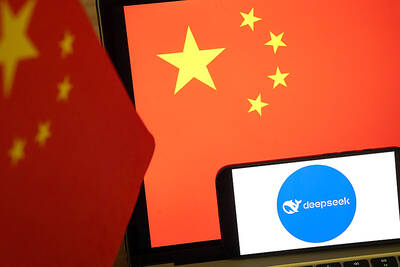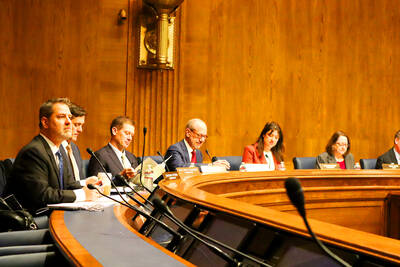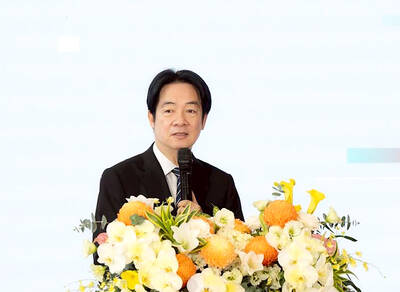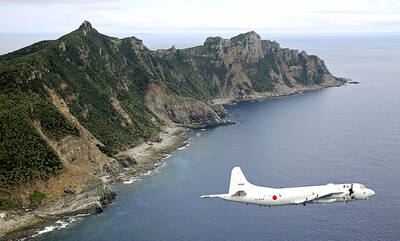Taiwanese Americans are expressing grave and increasing concern about eroding human rights back in their homeland.
At a series of meetings in Washington to celebrate the 30th anniversary of the signing of the Taiwan Relations Act (TRA), growing worries about freedom of speech and freedom of expression became the dominant theme.
Mark Kao (高龍榮), an official with the Formosan Association for Human Rights, told one gathering that Taiwanese students in the US are now often frightened to give their names if they say anything critical of President Ma Ying-jeou’s (馬英九) administration.
“We are deeply concerned about this situation,” Kao said. “There has been an erosion of human rights in Taiwan and it is getting worse since Ma took over last year.”
“I am often on university campuses and I find that students from Taiwan will not reveal their true identity when they speak critically of the Ma administration because they fear they will be harassed or made to suffer in some way when they go home,” he said.
Kao said that many Taiwanese students he had met in the US over the last few weeks believed that the government at home would take action against them if they were critical or complained about Ma’s pro-China policies.
“It is a common concern,” he said.
Eleven major Taiwanese organizations in the US met at the National Press Club on Friday to sign a petition to US President Barack Obama urging him to “break out of the stranglehold of the outdated ‘one China’ policy and move towards normalization of relations with Taiwan.”
White House sources said later that Obama would certainly read the petition, but that it was “highly unlikely” there would be any change in US policy.
A joint statement issued by the Taiwanese organizations said that as well as dealing with security issues, the TRA states that “the preservation and enhancement of the human rights of all the people on Taiwan” are objectives of the US.
“This clause was particularly important in 1979, when the Taiwanese still languished under the [Chinese Nationalist Party] KMT’s martial law, but equally relevant today, when we are witnessing an erosion of human rights and justice on the island,” the statement said.
Bob Yang (楊英育), president of the Formosan Association for Public Affairs, said: “Taiwan being a fledgling, young democracy, and having witnessed setbacks against democracies in Southeast Asia, the Middle East and other parts of the world, we are and must continue to be vigilant in safeguarding Taiwan’s democracy and freedom.”
Helen Loo (翁進治), representing the North American Taiwanese Women’s Association, said: “Today, a great majority of the Taiwanese want to keep their hard-won freedom. But the Ma Ying-jeou government is working against the wishes and welfare of the people of Taiwan by pursuing an agenda of incremental capitulation to China by reducing the budget and size of Taiwan’s military, deepening the dependence of Taiwan’s economy on China and downgrading Taiwan’s international status ... There is no human right more basic than the right of self-determination.”
Also on Friday, a large group of Taiwanese — including four who had traveled from Taiwan to participate — completed a 222km walk from Independence Hall in Philadelphia to the White House.
They were marching to protest Ma’s policies, which they said were pushing Taiwan closer to China.
“While a great majority of the Taiwanese people reject Chinese communist rule, the KMT government is rapidly paving the ground for annexation by China,” said Jay Loo (盧主義), one of the organizers. “Economic integration measures negotiated by the Chinese Communist Party and the KMT are implemented by the Executive Yuan without public debate or approval by the Legislative Yuan. Taiwan is in danger of being delivered into China’s grasp by stealth.”
Later on Friday, at an overflow meeting in a large Congressional committee room on Capitol Hill, John Tkacik, a former US State Department official and acknowledged expert on Taiwan, said that the last five years had not been kind to the TRA.
Many of those present — having come directly from the march from Philadelphia — could not get a seat and were forced to stand in the corridor outside listening through an open door.
Tkacik said the Obama administration was continuing the policies of former US president George W. Bush and was looking to “reach an understanding with China on Taiwan.”
“It’s not that the Obama administration has anything against Taiwan, but just because it feels it can no longer afford to maintain the capacity to resist the use of force in the Taiwan Strait,” Tkacik said.
“I think the ‘one China’ policy will go down in the history of the 21st century as perhaps the most disastrous American strategic move of the century. It is a move that has placed responsibility for the security and human rights of democratic Asia, including Taiwan, in the hands of China,” Tkacik said.

MISINFORMATION: The generated content tends to adopt China’s official stance, such as ‘Taiwan is currently governed by the Chinese central government,’ the NSB said Five China-developed artificial intelligence (AI) language models exhibit cybersecurity risks and content biases, an inspection conducted by the National Security Bureau (NSB) showed. The five AI tools are: DeepSeek, Doubao (豆包), Yiyan (文心一言), Tongyi (通義千問) and Yuanbao (騰訊元寶), the bureau said, advising people to remain vigilant to protect personal data privacy and corporate business secrets. The NSB said it, in accordance with the National Intelligence Services Act (國家情報工作法), has reviewed international cybersecurity reports and intelligence, and coordinated with the Ministry of Justice Investigation Bureau and the National Police Agency’s Criminal Investigation Bureau to conduct an inspection of China-made AI language

LIMITS: While China increases military pressure on Taiwan and expands its use of cognitive warfare, it is unwilling to target tech supply chains, the report said US and Taiwan military officials have warned that the Chinese People’s Liberation Army (PLA) could implement a blockade within “a matter of hours” and need only “minimal conversion time” prior to an attack on Taiwan, a report released on Tuesday by the US Senate’s China Economic and Security Review Commission said. “While there is no indication that China is planning an imminent attack, the United States and its allies and partners can no longer assume that a Taiwan contingency is a distant possibility for which they would have ample time to prepare,” it said. The commission made the comments in its annual

‘TROUBLEMAKER’: Most countries believe that it is China — rather than Taiwan — that is undermining regional peace and stability with its coercive tactics, the president said China should restrain itself and refrain from being a troublemaker that sabotages peace and stability in the Indo-Pacific region, President William Lai (賴清德) said yesterday. Lai made the remarks after China Coast Guard vessels sailed into disputed waters off the Senkaku Islands — known as the Diaoyutai Islands (釣魚台) in Taiwan — following a remark Japanese Prime Minister Sanae Takaichi made regarding Taiwan. Takaichi during a parliamentary session on Nov. 7 said that a “Taiwan contingency” involving a Chinese naval blockade could qualify as a “survival-threatening situation” for Japan, and trigger Tokyo’s deployment of its military for defense. Asked about the escalating tensions

DISPUTE: A Chinese official prompted a formal protest from Tokyo by saying that ‘the dirty head that sticks itself out must be cut off,’ after Takaichi’s Taiwan remarks Four armed China Coast Guard vessels yesterday morning sailed through disputed waters controlled by Japan, amid a diplomatic spat following Japanese Prime Minister Sanae Takaichi’s comments on Taiwan. The four ships sailed around the Senkaku Islands — known as the Diaoyutai Islands (釣魚台) to Taiwan, and which Taiwan and China also claim — on Saturday before entering Japanese waters yesterday and left, the Japan Coast Guard said. The China Coast Guard said in a statement that it carried out a “rights enforcement patrol” through the waters and that it was a lawful operation. As of the end of last month,